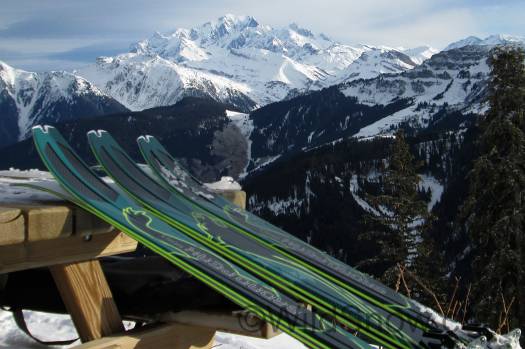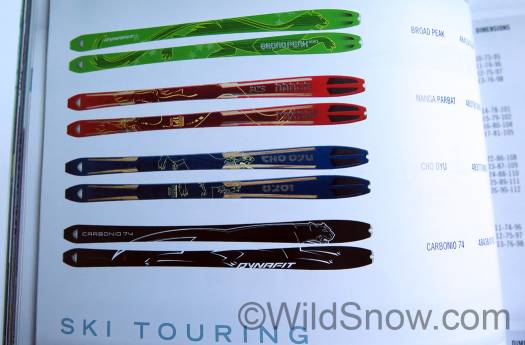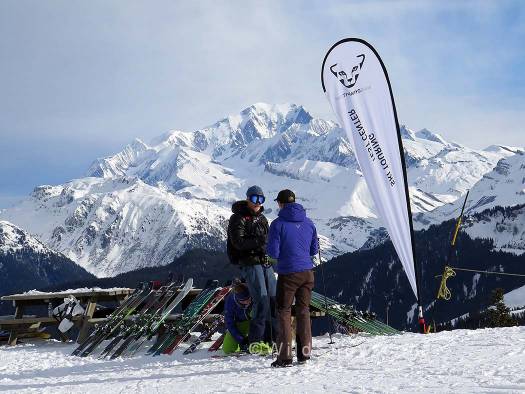
On the sunny side of Mont Blanc, Dynafit Broad Peak ski lined up for testing. Note the new 2015-16 version is a bright shade of green.
We’ve stayed a few extra days in France, here at hotel where Dynafit has a bunch of dealers in clinic. Thus, we’re able to continue consuming the smorgasbord of product. Today the groups broke up into a few ski tours as well as a ski evaluation on the pistes of Areches Beaufort. I’d have liked to tour, but the opportunity for a private ski test was too good to pass up.
Conditions were firm, groom to ice, with small patches of packed powder and chop. French powder! I took first run on my Cho Oyu pair for a baseline. They’ll not change for next year and are still one of my all-time favorite planks. Sure enough, the “Choodies” yielded good edge-hold and were carvy enough to enjoy. They were slightly nervous, but not to the point of misbehaving.
This next season (2015-2016) all Dynafit skis will be made by Fischer, all with construction optimized for strength to weight ratio (as well as performance for their given category). I’ve been impressed by what Fischer is doing with their branded touring ski lineup, so combining their tech with Dynafit’s goals has to be good.
The skinny “speed touring and mountaineering” Broad Peak model keeps its name, but has all-new construction that’s said to be lighter and at the same time damper. I skied the 167, short enough to know right away if any lack of damp would cause strife. At sidecut 112/75/97 (“37 mm sidecut”) you feel the lack of platform — at the same time you get edge bite enhanced by that same geometry. I hadn’t skied this narrow in a while. It’s a fun feeling, but not one I’d prefer on unsupportive snow. The skis were surprisingly damp for a carbon reinforced lightweight (catalog 1050 grams). Dynafit says this ski is suitable for ski mountaineering where “white ice” may require a specialized tool. They also suggest this as a citizen racing ski. Personally, I’d want something with a bit less sidecut for racing (for easy relaxed big-turn downhilling), as well as for skiing steep hard snow.
Next up, Baltoro. The perfect “80 mm” European touring ski, the pair of 176 I skied measure out at 116/84/103 (“32 mm sidecut”) with a dual 23/20.5 radius. I felt immediately at home on the Baltoro. They easily tilted into a strong carve, and just as with the Broad Peak I was surprised at their degree of dampness. At 1490 grams the 176 is reasonably light, but not a cupcake. Overall, after hitting perfect groom followed by frozen snowcat droppings under a snowmaking machine, I concluded these are a nicely forgiving plank that would support any level of skier.
I’d recommend the Baltoro is you’re looking for an “80.” As for Broad Peak, they were not my preference but could be yours if you want something narrow and agressive, and light. As always, try to demo before you buy. But if not, these two planks are quite the contrast, and that makes shopping decisions easier.

Dynafit ‘Speed Touring’ category for 2015-2016 is really just the lighter weight “Ski Touring” choices. Greener Broad Peak at top. Carbonio is ‘interesting’ at 990 grams for a 167 cm length.
As an FYI, here is Dynafit’s ski lineup for 2015/2016:
DNA (full on skimo race ski)
PDG (citizen racing and racer training ski)
Carbonio 74 (a new skinny “one kilo” ski that’ll be fun for all)
Broad Peak (skinny “75 mm” for ski running or mountaineering hard conditions)
Cho Oyu (unchanged from last season, recommended)
Nanga Parbat (specialized 80 mm waist ski for extreme alpine descents)
Baltoro (damp and solid, 84 mm waist, in a word “strong)
Baltoro Women
Manaslu (similar to Cho Oyu, slightly wider)
Manaslu Women (claimed to be a bit more flexy and lighter)
Laila Peak (The exalted, the mysterious, the Laila, Clapton riff?)
Seven Summits (I’m not sure where this fits in, 82 mm waist for Euros?)
Denali (“100 waist” light “freeride” ski)
Chugach (heavier full rocker freeride, 108 waist)
Hokkaido (heavier full rocker freeride, 118 waist)
WildSnow.com publisher emeritus and founder Lou (Louis Dawson) has a 50+ years career in climbing, backcountry skiing and ski mountaineering. He was the first person in history to ski down all 54 Colorado 14,000-foot peaks, has authored numerous books about about backcountry skiing, and has skied from the summit of Denali in Alaska, North America’s highest mountain.

